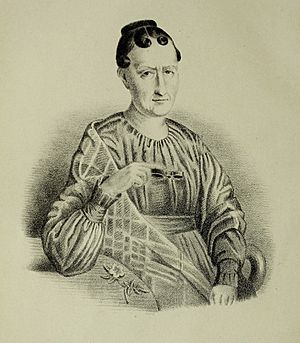Marie-Anne Libert facts for kids
Quick facts for kids
Marie-Anne Libert
|
|
|---|---|
 |
|
| Born | 7 April 1782 |
| Died | 14 January 1865 (aged 82) |
| Nationality | Belgian |
| Scientific career | |
| Fields | Botany, mycology, plant pathology |
Marie-Anne Libert (born April 7, 1782, in Malmedy, Belgium; died January 14, 1865, in Malmedy) was an amazing Belgian botanist and mycologist. This means she studied plants and fungi. She was one of the very first women to become a plant pathologist, someone who studies plant diseases. Sometimes, people call her "Anne-Marie Libert."
Contents
A Young Mind Full of Curiosity
Marie-Anne Libert was born in Malmedy in April 1782. She was the twelfth of thirteen children! Her parents, Henri-Joseph and Marie-Jeanne-Bernadine Libert, were educated and ran a tanning business. They quickly saw how smart she was.
When she was young, Marie-Anne went to school in Malmedy. At age eleven, her parents sent her to Prüm in Germany. There, she learned German and how to play the violin very quickly. Her father also taught her math, like algebra and geometry. He wanted her to help with the family business. But Marie-Anne loved learning so much that she went far beyond what was needed for the business.
While other kids her age just wanted to play, Marie-Anne was always eager to learn new things. She was especially drawn to nature. She spent many hours walking around Malmedy, especially in the High Fens. She would carefully watch, collect minerals and plants, and then identify them. She even taught herself Latin because many important books were written in that language.
Discoveries in Botany and Fungi
Marie-Anne's work in botany, especially with cryptogams (plants that reproduce without seeds or flowers, like mosses and fungi), was very accurate. This made her famous around the world. She wrote letters to scientists in Belgium and other countries.
She also worked with a doctor named Alexandre Louis Simon Lejeune. He was creating a list of plants in the Ourthe region. Dr. Lejeune introduced Marie-Anne to a Swiss botanist, Augustin Pyramus de Candolle. He encouraged her to study cryptogamic plants. Later, Marie-Anne created her own list of cryptogamic plants found in the Ardennes region.
Solving the Potato Blight Mystery
Marie-Anne was one of the first people to figure out what caused the "late blight" disease in potatoes. This disease caused a lot of problems, especially during the Irish Potato Famine. She named the organism Botrytis vastatrix and wrote a detailed description of it in 1845.
Later, a German mycologist named Anton de Bary used her discovery. In 1876, he showed that a type of water mold, which he renamed Phytophthora infestans, was the real cause of late blight. Before this, many people thought the disease was a result of bad conditions, not caused by a living organism.
Marie-Anne also described many other fungi that cause plant diseases. For example, she identified Alternaria cheiranthi, which harms wallflower plants. She also found Fusarium coeruleum, which causes dry rot in potatoes. In total, she described over 200 new types of organisms!
Other Fascinating Interests
Marie-Anne's interest in old languages led her to study archaeology. In her later years, when she couldn't walk around the countryside as easily, she spent a lot of time studying the history of the Principality of Stavelot-Malmedy. She used the same careful scientific methods for history and archaeology as she did for her plant studies.
Besides her collection of dried plants (called a herbarium), she also collected beautiful pearls. She found these pearls from large pearl mussels in the Amblève river and its smaller streams. She also had a big collection of old coins.
Even with all her scientific work, Marie-Anne was still very involved in her family's tanning business. She worked hard and wanted to do well in everything. She and her brothers even made the small tannery much bigger. After a short illness, Marie-Anne Libert passed away in Malmedy on January 14, 1865.
How She Was Honored
Two types of living things were named after her:
- Libertia: A group of plants in the iris family.
- Libertiella: A type of fungi.
A nature club in Malmedy, started in 1951, later changed its name to "Cercle Royal Marie-Anne Libert" to honor her. In 1965, 100 years after she died, a special stone monument with her picture was put up in the Tanneries Park (now called Parc Marie-Anne Libert) in Malmedy. Also, a street in Malmedy was named Rue Marie-Anne Libert in 1925.
In 1820, she became a member of the Linnean Society of Paris, a famous scientific group. The Emperor Friedrich-Wilhelm III even gave her a gold medal for her amazing work. In 1862, she was the first woman ever invited to join the Royal Botanical Society of Belgium.
Her Important Books
- (1826). Mémoires sur des cryptogames observées aux environs de Malmedy (Memories of cryptogams observed around Malmedy)
- (1830–1837). Plantae cryptogamicae quas in Arduenna collegit M. A. Libert. 4 volumes (Cryptogamic plants collected by M. A. Libert in the Ardennes)
See also
In Spanish: Marie-Anne Libert para niños

